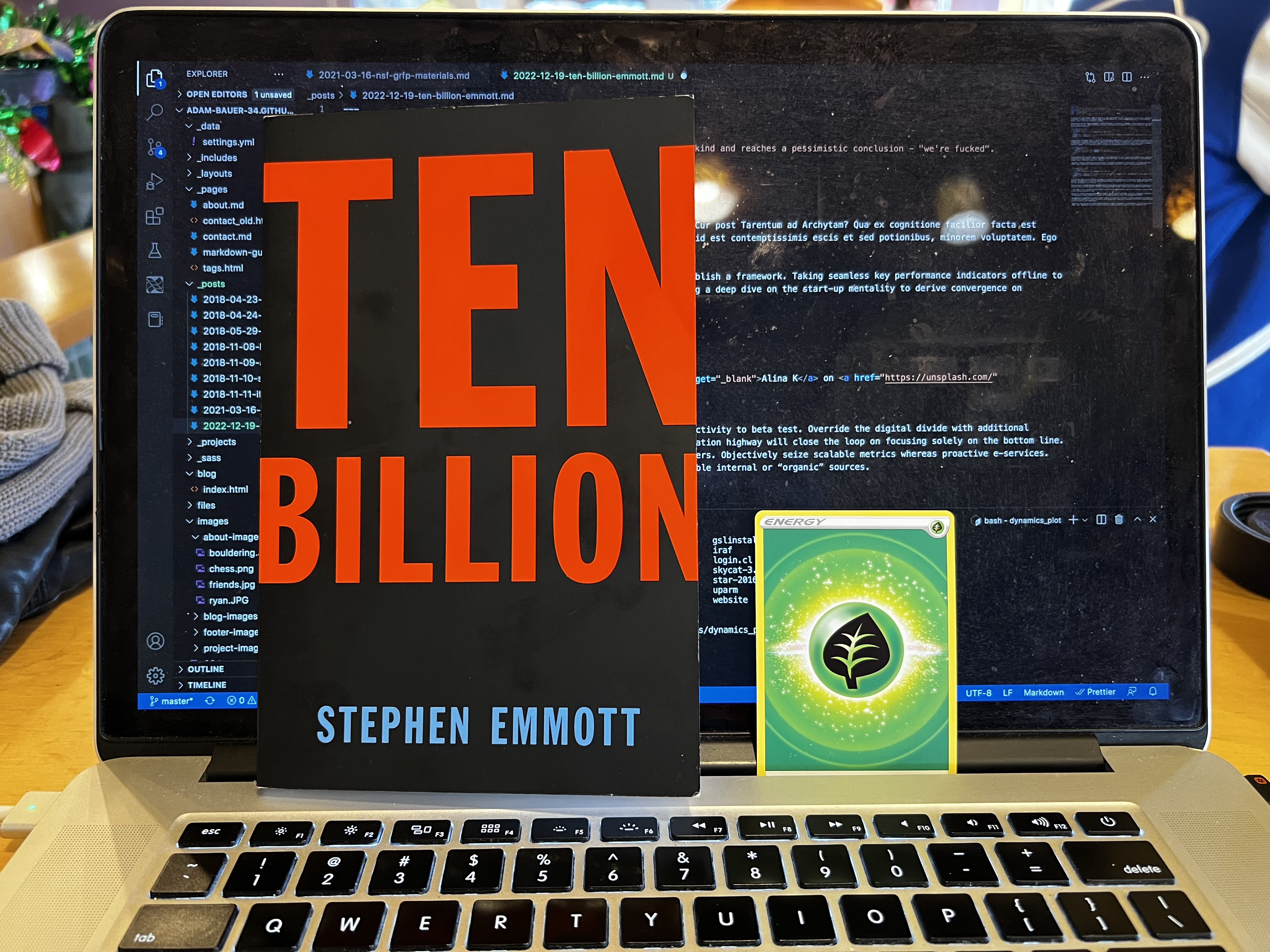Stephen Emmott, the head of Computational Science at Microsoft Research, as well as a Visiting Professor at Oxford University and University College London, lays out in Ten billion the various problems that face the world today. (And by today, I mean 2013, when the book was written.) This book is a relatively quick read (I read it in about 2 hours), primarily owing to the fact there is about one paragraph or so per page. In fact, numerous pages contain just a single sentence, a structure I’ll return to later on.
The goal of this book is to outline the problems inherent to population growth — more precisely, the concern of reaching a total population of ten billion people (hence the title). Energy, food, land, and water demand are all expected to increase dramatically in the coming years because of the burgeoning population, and therefore put significant stress on a variety of economic and human systems.
The general structure of Mr. Emmott’s writing is to show a variety of “hockey stick”-like graphs, which show how for millions of years the human race had a very small population (for example), and in the last few thousand years we’ve exponentially grown in population. Same goes for energy demand, CO2 concentrations in the atmosphere, CO2 emissions, and so on. These plots really do put into perspective the rapid rate of change in human society, especially after the Industrial Revolution in the late sixteenth and early seventeenth centuries.
To dig a little bit more on Mr. Emmott’s particular concerns, the first he discusses is also dear to me: climate change. He shows the CO2 concentrations in the atmosphere over time, as well as the energy demand, coal usage, warning that essentially each of these key quantities has only gone up in time, and is expected to continue to grow with rising population. This will lead to increased global temperature change, significant economic and ecologic damage, as well as being detrimental to human health. These concerns are still very relevant today, but perhaps not to the extent that Mr. Emmott described.
Indeed, Mr. Emmott’s writing on climate change has not aged well. He quotes that the world we currently reside in is headed for 4 °C of warming by 2100, with a significant probability of reaching 6 °C. This claim is only true insofar as one believes that we were headed on the highest possible emissions scenario. Current trends in CO2 emissions, however, do not track with this emissions scenario, and the best projections I know of at the time of writing estimates about 2—3 °C of warming by 2100. Now, this is still far too much, but not nearly the 4—6 °C of warming that Mr. Emmott anticipates and rightfully fears.
The remainder of Mr. Emmott’s concerns regard demand across a variety of sectors, such as land, water, and food. Mr. Emmott does well in this discussion to highlight the interdependency of these demands; increased food demand puts increasing stress on water demand, for example, owing to the increasing demand for water to either irrigate crops or feed livestock.
The increased demand for land also influences climate solutions, as carbon dioxide removal technology is also land-intensive, so even if we could “suck the excess CO2 out of the atmosphere,” it would still serve as a major stress on global land demand. Shall we cut down yet more rainforest to make room for more “efficient” CO2 removal technology?
Much of what Mr. Emmott discusses in this book are still relevant concerns today. However, armed with hindsight, the reader quickly sees that much of his worries were overstated. This, for me, signals two truths.
The first is that projections of the future must always be taken with some grain of salt. Regardless of how certain one is that present trends will continue, the future is often too uncertain owing to both uncertainty that one is aware of — “known knowns” and “known unknowns”, to quote former United States Secretary of Defense Donald Rumsfeld — and, crucially, uncertainty one is not aware of — “unknown unknowns.”
For example, Mr. Emmott puts forth towards the end of Ten billion that humanity is not moving quickly towards cutting CO2 emissions, and that he sees no evidence that this would change given the increasing trends in demand he discussed earlier. What he failed to see was the forthcoming Paris Agreement in 2016 that led to the first warming target acknowledged by a variety of countries across the world. Of course, i’s not Mr. Emmott’s fault he failed to foresee this monumental event— how could he? — but the Paris Agreement does make his final conclusion that “we’re fucked” seem laughable at worst, and premature at best.
My second takeaway from Ten billion is that the rate at which the world can change is often incredibly underestimated when considering future change. Mr. Emmott stressed to no end the rate at which the past has changed, but claims vehemently that the future will contain no such rapid change. Could one in the 1950s had predicted that US African Americans would have the right to vote in 1964? Hell, President Barack Obama famously endorsed civil unions of same-sex couples in 2008 before flipping his view on the matter in 2012. Could anyone in 2011 have foreseen this? Or even the day before Pres. Obama’s interview where he made his stance public? The point here is not to discredit anyone who projects the future, but it does reveal an inherent bias we as a public have towards prognosticating the future.
This perspective makes Mr. Emmott’s writing — full of in your face, punchy pull-quotes and dystopian imagery — fall flat. He comes across as strikingly alarmist, without ever caveating his projections with any perspective towards how the world could change in a not-so-horrible way. And perhaps this is exactly what he set out to do: to paint an image of the world that stirs up conversation and action to make sure that future change does not resemble present-day trends. But to view this book as anything other than a 200 page version of a Twitter rant would be, in my view, a mistake.
I wouldn’t exactly recommend it, unless you want to buy it for your climate denying uncle for Christmas. Then maybe that’ll do some good.
Rating: world population in 50 AD ⁄ world population in 2022 AD
Pokémon card for this book: I chose a grass energy card for this book because I was told the book would “energize me to continue doing work on climate change.” After reading, I would say I’m only more energized to keep alarmism, in all its forms, in the perspective of history.




